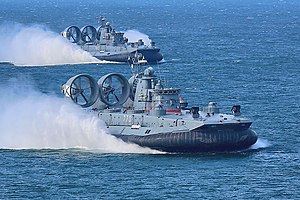Zubr-class

Mordoviya and Evgeniy Kocheshkov
|
|
| Class overview | |
|---|---|
| Builders: | PO More Feodosia Shipbuilding Company, Crimea |
| Operators: | |
| In commission: | 1988–present |
| Planned: | 17 |
| Completed: | 15 |
| Cancelled: | 2 |
| Active: | 10 |
| Retired: | 5 |
| Scrapped: | 5 |
| General characteristics | |
| Type: | Air-cushioned landing craft |
| Displacement: |
|
| Length: | 57 m (187 ft) |
| Beam: | 25.6 m (84 ft) |
| Draught: | 1.6 m (5.2 ft) |
| Propulsion: |
|
| Speed: |
|
| Range: | 300 nmi (560 km) at 55 knots |
| Complement: | 31 (4 officers, 27 enlisted) |
| Sensors and processing systems: |
Ekran-1 navigational radar, Lazur radar (Pozitiv radar on MDK-51), R-782 Buran communications system |
| Electronic warfare & decoys: |
Electronic Countermeasures System: Decoys, MS-227 chaff launcher, MP-411 ESM radar system; intercept |
| Armament: |
|
The Zubr class (Project 1232.2, NATO reporting name "Pomornik") is a class of air-cushioned landing craft (LCAC). This class of military hovercraft is, as of 2012, the world’s largest, with a standard full load displacement of 555 tons. The hovercraft is designed to sealift amphibious assault units (such as marines and tanks) from equipped/non-equipped vessels to non-equipped shores, as well as transport and plant naval mines.
There are ten Zubr-class hovercraft in service. There are two vessels in the Russian Navy and four with the Hellenic Navy. In 2009, China placed an order for four vessels from Ukraine [order transferred to Russia now] as part of a deal worth 315 million USD. Two updated versions of the vessels were built by Crimea's Feodosia Shipbuilding Company, followed by two advanced models of the surface warship.
The purchase of HS Cephalonia (L 180) for the Hellenic Navy marked the first time a Soviet-designed naval craft had been built for a NATO member.
In June 2017, Russia announced it was restarting production of the Zubr-class craft. Representatives from the Russian shipbuilding industry soon after responded by stating production could not possibly resume in 2018 and would only be possible by 2019–2021, refuting the government position. Representatives cited the lack of availability of and inability to mass-produce components, notably gas turbine engines and reduction gears as the main obstacles.
NPO Saturn (ODK GT) and Turboros developed marine gas turbine M70FRU (D090), FR RU, M70FRU2 (DP/DM71) along M90FR, M75RU, E70RD8 and Elektrosila, AO Zvezda, Metallist, Samara and others developed reductors and gears. Fan and Turboprop provided by NK Kuznetsov, Aerosila, among others (perhaps some like Aviadvigatel, Salut, AMNTK, UMPO, KMPO, having high and long experience and production).
...
Wikipedia
